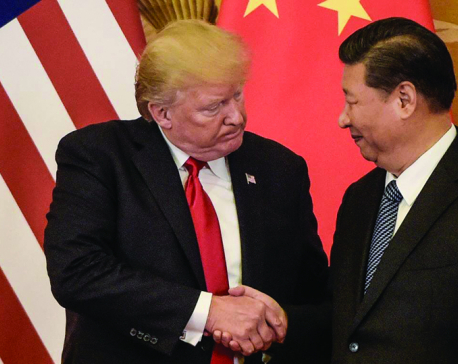
OR
Human-wildlife conflict a big threat to conservation efforts in Kanchenjungha Landscape
Published On: December 15, 2018 02:00 AM NPT By: Republica | @RepublicaNepal
KATHMANDU, Dec 15: Human-wildlife interaction or conflict has been identified as the biggest threat to conservation efforts in the Kanchenjunga Landscape. Similarly, wildlife has been identified as the largest threat to the livelihoods of rural communities in the region.
The incidents of human-wildlife conflict have been rising for several reasons. Over a decade (2000-2010), 1,118 sq.km of habitat types such as riverine grasslands and tree cover were lost in the Landscape, 74 percent of which was converted to rangeland and 26 percent to agricultural land, according to the International Center for Integrated Mountain Development (ICIMOD). The loss and degradation of wildlife habitat, which consequently affects food availability, increase the probability of wildlife intrusions into human settlements, resulting in crop and livestock depredation, infrastructure damage, and loss of human life.
Various mitigation measures to address human-wildlife conflicts have been implemented in the Landscape, including crop/livestock guarding, physical and electric fencing, sound and/or light alarm systems, and livestock insurance schemes. However, in some areas, retaliatory killing of wildlife species has also been reported.
Much of this elephant habitat has been significantly altered and is obstructing traditional migration paths. On the other hand, the number of elephants has also increased due to conservation efforts. As a result, conflicts between humans and elephants, resulting in the destruction of infrastructure and crops, as well as occasionally causing human fatalities, have been on the rise.
The Kangchenjunga Landscape is home to charismatic wildlife species such as the snow leopard, red panda, pangolin, takin, Himalayan black bear, and musk deer – all of which are globally threatened. Many of these species are threatened by poaching for the illegal trade of their body parts including pelt/scales, bile, or musk. Illegal trade of pangolin scales, tiger pelts, rhino horns, butterflies and rhino beetles have been reported from eastern Nepal bordering India, according to ICIMOD experts. “Greater cooperation across borders can also help address some factors influencing poaching and illegal trade in the border areas of the landscape – a lucrative market, porous borders, and insufficient patrolling.”
Over the weeklong site visits and meetings, representatives of related line agencies from Bhutan, India, and Nepal, government institutions involved in curbing wildlife crime and relevant non-government and civil society organizations, developed a shared understanding of regional, bilateral, and local issues related to human-wildlife conflicts and wildlife crime. The road-map which will be developed collectively will outline short-term, medium-term, and long-term actions and measures that will be implemented.
Speaking at an even titled 'Reconciling Human-Wildlife Interface in the Kanchenjunga Landscape: Regional Dialogue for Action' organized by West Bengal Forest Directorate and ICIMOD in Siliguri of India recently, Dr Soumitra Dasgupta, Inspector General of Forests (Wildlife), who was representing the Ministry of Environment, Forest and Climate Change of India, said, “Wildlife does not understand political borders and for communities in the forefront of human-wildlife conflict, it is a stressful situation.”
Gopal Prakash Bhattarai, an official of the Department of National Parks and Wildlife Conservation, who led the official delegation from Nepal, stressed, “There is an urgent need to collectively monitor, study and share information in a timely manner about movement of wildlife in the landscape.”
“Human-wildlife conflict is without doubt a major challenge for all three countries, but illegal trade in wildlife is also an important issue which needs to be addressed collectively by our three countries,” said Tashi Tobgyel from the Department of Forests and Park Services, and the leader of the Bhutanese delegation.
You May Like This

Be an ally for female journos, award-winning Canadian journalist tells male journalists
KATHMANDU, Feb 23: Male journalists must be stronger allies for their female counterparts by supporting women to take up decision-making... Read More...

Defusing US-China trade conflict
The current US-China trade conflict has been decades in the making; rolling it back will require both sides to acknowledge... Read More...

Controlling cyber conflict
LAS VEGAS: When cyber-security professionals were polled recently at their annual BlackHat conference in Las Vegas, 60 percent said they... Read More...




Just In
- Health ministry to conduct ‘search and vaccinate’ campaign on May 13
- Indian customs releases trucks carrying Nepali tea, halted across Kakarbhitta
- Silent period for by-election to begin from midnight
- SC issues short-term interim order to govt and TU not to take immediate action against TU legal advisor Khanal
- National consultation workshop advocates to scale up nutrition smart community in Nepal
- Patan High Court issues short-term interim order to halt selection process of NTB’s CEO
- NEPSE inches up 0.15 points; daily turnover increases to Rs 2.53 billion
- Bagmati Govt mandates tri-lingual signboards in offices














Leave A Comment